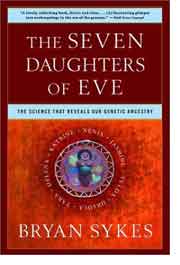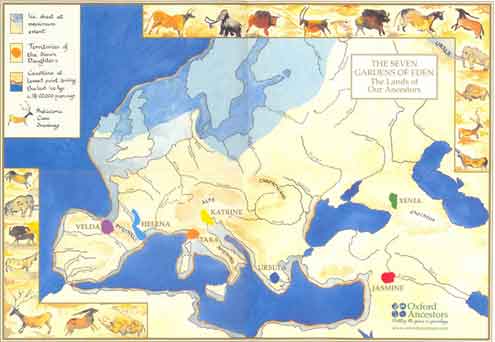
Once I got into DNA testing, I kept seeing references to The Seven Daughters of Eve. This is a book by British geneticist Bryan Sykes. He pioneered the use of DNA to determine the ancient genetic ancestry of modern humans.
After I had my mtDNA tested, I bought and read the book. While I expected to learn a lot about mitochondrial DNA, I was surprised at how enjoyable it was to read. Sykes takes the reader step by step through the challenges and opportunities he faced in developing the science of mitochondrial genetics.
To order this book from Amazon.com click Seven Daughters of Eve.
Here are some highlights of The Seven Daughters of Eve that I found particularly interesting:
Mitochondrial DNA
Mitochondria are tiny structures that exist within every cell. Unlike chromosomes, they are not in the cell nucleus but outside in the cytoplasm. They help cells use oxygen to produce energy. Each mitochondrion includes a tiny piece of DNA.
Since mitochondria are present in eggs but absent in sperm, everyone gets their mitochondria from their mother. Men and women both have it in their cells. But only women pass it on to their children.
Sykes decided to look for mitochondrial DNA in his studies of ancient human remains. Cells have a hundred times more of it than any other gene. So there was a better chance of finding some preserved in ancient bones and teeth. Furthermore, mitochondrial DNA mutates at a known average rate, so the mutations can provide an objective time measurement.
The Iceman
The Seven Daughter of Eve begins with the discovery of a 5,000-year old frozen body in the Italian Alps. Sykes found the Iceman had the same mitochondrial DNA as modern Europeans. In fact, it matched one of his modern samples exactly. This is when he realized that we are all genetically linked to people who lived thousands of years ago.
The Polynesians
The Polynesians settled all over the Pacific on islands as far apart as Hawaii, Tahiti, and New Zealand. But where did they come from originally? Was it Asia or Latin America? Since the winds and currents of the Pacific move from East to West, it would have been easier to come from Latin America.
Thor Heyerdahl, the Norwegian anthropologist, showed it was possible to drift 4,000 miles on a primitive raft from Latin America to islands near Tahiti. His voyage of Kon-Tiki proved it was possible. But did it really happen that way?
Sykes sampled enough Polynesian descendants to find the DNA of the original Polynesians and compared it to Asian and Latin American samples. He proved that the Polynesians came from Asia and not Latin America. Specifically, they came from coastal China or Taiwan.
The Neanderthals
In 1856 workmen quarrying limestone in the Neader valley of Germany found the bones of an ancient human. Similar skeletons have been found since then. Were these “Neanderthals” the ancestors of modern humans or just an evolutionary dead end?
Sykes showed that modern Europeans must trace their ancestry to more recent arrivals, the Cro-Magnons. The Cro-Magnons were part of our homo sapiens species. But the Neanderthals were an example of a different human species and they eventually died out.
The Seven Daughters of Eve
The title of Sykes’ book comes from the fact that 95% of Europe’s current population falls into just seven mtDNA haplogroups, categorized by the letters U, X, H, V, T, K, and J. If each European could track their maternal line back through their mother’s mother etc., 95% of them would eventually reach one of seven ancient women.
Sykes personalized these “clan mothers” by giving them names that start with the seven haplogroup letters: Ursula, Xenia, Helena, Velda, Tara, Katrine, and Jasmine. He combined DNA and anthropology to explain roughly where and when each woman lived. Then he personalized the women some more by telling a fictional story about each of their lives.
You can see their origins on the following map:
Mitochondrial Eve

All seven daughters of Eve and another 26 global haplogroups can be traced back further in time to “Mitochondrial Eve,” a woman who lived about 140,000 years ago in Africa. All of us are her direct maternal descendents.
Humans originated in Africa and have been on that continent long enough for 13 separate clans to develop. Yet only one of those clans left Africa and split into the different haplogroups that now populate the rest of the word. These ancient African roots go back long before the relatively recent categories of people discussed under Ethnic Ancestry.
Buy This Book Now
You can order this book right now from Amazon.com. Just click on Seven Daughters of Eve.
Oxford Ancestors
Bryan Sykes is a Professor of Human Genetics at Oxford University in England. He founded the DNA testing company Oxford Ancestors. To learn more about The Seven Daughters of Eve, visit Oxford Ancestors.
